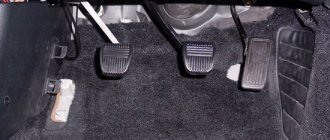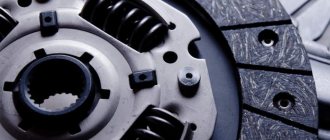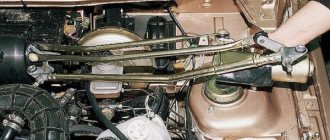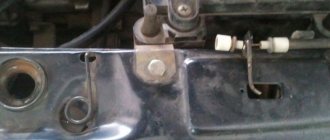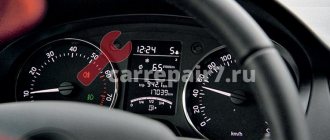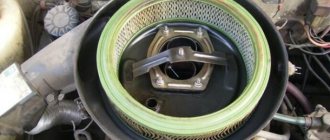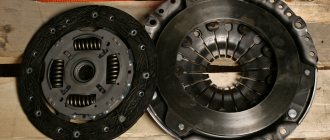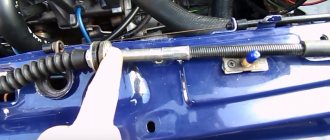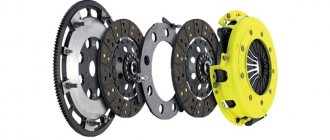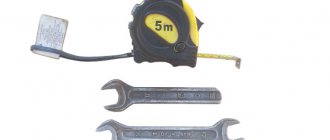- The return spring is faulty. Said clutch return spring creates resistance that pushes the pedal back after the driver stops pressing it. Simply put, by removing your foot from the clutch, the pedal should return to its original position on its own. If the spring has burst, shifted or is extremely worn, then the clutch pedal may not return or may become stuck. To fix the problem, you need to disassemble the return mechanism and change the spring;
The next problem on the list is the failure of the clutch fork. As a rule, the specified fork needs to be changed, since it actively wears out and is then damaged during operation;
Please note that if clutch failure occurs due to problems with the master cylinder, the functionality of the clutch pedal can be partially restored by pressing it sharply. This method is suitable as a temporary solution to get to the repair site.
However, it is not recommended to drive for a long time in this way, as this can result in other damage. For this reason, the owner of a car with a manual transmission must know how to drive without a clutch, how to engage a gear (speed) without a clutch, etc. Such skills allow you to combine available methods, which makes it possible to minimize the risks of additional malfunctions when driving with a faulty clutch.
Driving without a clutch: what you need to know
Taking into account the fact that most breakdowns that are associated with the clutch or clutch pedal (for example, the clutch pedal has failed) can take the driver by surprise, and it is often impossible to fix problems on the spot, the only option is to drive to the service station under your own power.
At the same time, we draw your attention once again to the fact that the methods described below should be used only in cases of extreme necessity, since the risk of damaging the box or getting into an accident increases significantly.
- So, first you need to turn off the car engine. If you lose traction on a hill, you should push the car onto a level road. Then it is recommended to think over the route in advance so that, if possible, you travel along a route with a minimum number of traffic lights, pedestrian crossings, not congested with traffic, so that you do not have to stop often, etc.;
- Next, with the engine turned off, you should engage first gear, and you also need to turn on the emergency lights, after which the engine can be started (note that the car will jerk forward sharply immediately after turning the key in the ignition switch to the “start” position);
Let us also add that beginners in such a situation should be prepared for the fact that the engine will stall when it comes to a complete stop or greatly reduces the speed without turning off first gear. This means that in this case you will have to start again on the first one.
This is possible if the driver feels when engaging a gear without a clutch with minimal effort can, without much risk, seriously damage the gearbox and transmission parts, taking into account engine speed and speed. However, if you try to do this without experience and skills, there is a high risk of damaging the gearbox, significantly reducing the life of the unit, or completely destroying the gearbox and other transmission elements.
Let's get started
So, we drive the car into the pit and block the rear wheels by holding the parking brake lever. We reset the box itself to “neutral”. Next, we tear off the wheel bolts and raise the front left part of the car. After removing the wheel, you will need to unscrew the bolts securing the lower ball joint. You should also remove the mass air flow sensor and the clamp securing its pipe. We also take out the air filter. Next, remove the clutch cable from the fork. To do this, loosen the two nuts that attach the cable to the bracket on the transmission. After this, remove the negative terminal from the battery and unscrew the starter mounting bolt. Nearby, unscrew the gearbox mounting bolt using a 19 mm wrench with an extension. Remove the upper starter mount and remove the chip from the speed sensor. We also unscrew the speedometer cable, which is installed in the box.
After this, paired with a lever, we remove the longitudinal stretcher. We unscrew the third bolt securing the gearbox. It is located in the CV joint area. We unscrew the bolts securing the reaction rods and take them out. Next, loosen the nut that is located on the gearbox control rod clamp. We also extract the traction outwards. Next, install a stop under the engine.
It would be better if it was a jack. This way we can vary the position of the motor relative to the body. We place a block or piece of hard rubber on top under the support so as not to damage the elements of the power plant.
Next, unscrew the rear engine mount nuts. Then carefully remove the gearbox from the engine and lower it to the floor. The element will hang on the axle shaft. Now we have access to the clutch. We take out the basket along with the disk and perform troubleshooting.
Let's sum it up
As you can see, problems associated with the clutch on a manual transmission in some cases can completely immobilize the car. If the problem is related to the clutch pedal, that is, the driver loses the ability to control the operation of the clutch, then repair is also necessary, however, if you have certain skills and abilities, you can drive to a service station or other place where the car is repaired under your own power.
If necessary, it is also recommended to adjust the clutch pedal, bleed the clutch, and also take into account even the slightest malfunction of this unit during vehicle operation.
Types of clutch drive. If the clutch pedal falls, the clutch has become soft, problems have arisen with the clutch: causes and repair of major faults.
How to adjust the clutch pedal, what adjustment is needed for: clutch functions, clutch pedal adjustment (free play and total travel).
Manual transmission gears (speeds) do not engage after replacing the clutch: main reasons, settings and adjustments. Diagnosis of problems, useful tips.
Clutch disc: purpose and device. How to replace a clutch disc, replace this element yourself. Recommendations.
Car clutch and design overview: clutch pressure plate, driven disc, release bearing. Types of clutch drives on manual transmissions and manual transmissions.
How to replace the clutch on a DSG/S-Tronic robotic gearbox. Signs of the need for replacement, removal and installation of the DSG clutch, calibration and adaptation.
Incomplete inclusion
A characteristic symptom is that the transmission is difficult to engage or does not engage at all. May be accompanied by a strong crunch even with the pedal fully depressed. There are several reasons for this failure:
- Deformation or damage to the driven disk.
- Worn clutch fork.
- Incorrectly adjusted cable drive.
- Worn diaphragm springs on the clutch disc.
- Insufficient pedal travel.
- Lack of lubrication in the bearing guide sleeve.
- Different adjustment of pressure plate levers.
Causes and repair of a failing clutch pedal in a VAZ-2110
This is a fairly popular model of the domestic concern. It is distinguished by its versatility, reliability on various types of roads and inexpensive price. The technical characteristics of the car indicate that it is a five-seater vehicle, with an engine in the front and front-wheel drive. In popular usage this model is called the “tenth” or “tenth”. The clutch here is single-plate, dry with a diaphragm spring. The drive is driven by a special cable.
Most often, problems are observed if the cable is torn, then the pedal can not only fall to the floor, it completely refuses to work. It is much more unclear what this phenomenon means if the cable is intact, but a malfunction still occurs. In general, there are a lot of reasons for this, since the clutch is one of the most vulnerable points of a VAZ car, not only of the tenth model, but also of any other.
Why did the pedal start to fail?
In most cases, the reasons for this malfunction are the following:
- The cable connecting the pedal to the tip is broken.
- There is a burst or cracked release spring.
- One of the clutch elements is oily. This could be a flywheel, a pulley, or friction linings.
- Quite often the cause is general wear and tear of the clutch system.
- The clutch drive is damaged.
- Unadjusted pedal mechanism.
As you can see, the list is large, but not all problems here are critical and complex. For example, in the case of excess oil, it will simply be enough to clean and grind the parts.
In the first and second cases, it is necessary to completely replace the failed parts - cable or spring.
Replacing and repairing the clutch system
If the VAZ-2110 clutch pedal fails, quite often this indicates wear and failure of the entire clutch system. Here you can give the following algorithm of actions on the part of the car owner:
- first dismantle the gearbox;
- after this, unscrew 6 bolts that secure the casing and flywheel;
- you need to unscrew them evenly, and not one by one; if they do not turn, tap the parts a little;
- After this, the shafts are dismantled. If any of them have cracks or any damage, then the reason for the falling pedal is obvious and needs to be replaced;
- the new driven shaft is installed with the protruding side facing the pulley;
- the frame is inserted into the crankshaft hole and fixed again evenly and very carefully.
If the cable is the cause of the breakdown, then replacing it will not be difficult.
Drive and its adjustment
To begin with, if the reason is still in the cable and it needs to be changed, dismantle the old part. It is attached directly to the gearbox with a bracket. Here you also need to unscrew all the bolts and nuts slowly and evenly. Next, the fork is disengaged after the cable has been slightly loosened, but not completely removed.
The cable itself needs to be looked for under the hood of the vacuum hydraulic booster of the brake system. Use a screwdriver or other similar element to pry up and remove the locking bracket, and only then dismantle the part. Sometimes the reason is not in the cable, but in the bushing to which it is attached. It may be bent or out of order, making it difficult to secure even a new cable correctly. Therefore, if a breakdown occurs, then this part is also replaced. It is also advisable to lubricate the new cable with a special compound to prevent damage from friction.
This part requires regulation if installed in a VAZ-2110. It's easy to check everything. Take a ruler and measure the distance from the floor to the pedal strictly perpendicularly. If it is more than 16 centimeters, then all excess on the cable is cut off. When the new element is installed in the reverse order, you need to get behind the wheel and try the precision of the pedal.
Important points when replacing the cable
Unscrewing the fastener
- As practice shows, the procedure for replacing a cable on a “ten” begins in the engine compartment. You are required to hold the fork and at the same time pull the cable that is removed from the fork.
- Then the cable fastener is removed from the bracket, which is located on the gearbox. Having completed this procedure, we go into the interior and dismantle the damaged element, that is, the cable.
- The result of the repair is influenced not only by the quality of the new cable, but also by the correctness of the entire replacement procedure.
- If you are dealing with a “ten” from an experimental industrial batch, then the bracket will be presented as a bolt with a Phillips-head screwdriver. To dismantle such a fastening element, you cannot use a regular screwdriver. A special shortened tool will be required.
- If the cable breaks while driving, you can unscrew the bracket with a handy tool, but through the safety block.
- It is strongly recommended to replace the non-standard bolt with a regular one, which can be unscrewed with a simple wrench.
- Be sure to keep a set of tools in your car, since it is extremely rare for a cable to break at the right moment. There is hardly a right moment for any kind of machine breakdown.
The clutch pedal has failed, reasons, what to do
A car clutch failure is always unpleasant. In such a situation, you have to think about how to repair the car, what parts to buy for replacement, and where to get the money.
The clutch pedal has failed
In this case, the worst thing is if the malfunction manifests itself on the road. What to do if the clutch pedal fails? How to get to a garage or service station when the device refuses to work? Let's consider the solution using the example of a VAZ car. You need to know that the VAZ 2101-07 has a hydraulic clutch, and the VAZ 2108-2110, Lada Kalina and others use a cable.
Important Tips
If you understand that you can only rely on yourself, and you have to drive with a failed clutch pedal, follow the steps above.
But in order not to encounter unpleasant consequences, and also to actually apply the methods discussed, you need to take into account several important tips.
- As soon as you notice that the pedal has failed and does not work, do not rush to stop immediately. Assess your current environment and where you are. If you stop on the rise and then try to move from the place using the indicated methods, you will not succeed. Such methods do not work uphill. It is better if it is a slope or at least a flat section of the road;
- The engine must be warm before driving. When the pedal fails, many people first stop, try to understand what happened, wait for help, and only then understand the need to move on their own. During this time the engine cools down. For the methods to work, do not forget to warm up the engine at idle speed first;
- You can move exclusively in first, or maximum in second gear. Taking this factor into account, think about your upcoming route. Try to make sure that the entire route follows the main road, and you do not have to stop to let other vehicles pass. Unnecessary manipulations with the gearbox and operating pedals with a faulty clutch can aggravate the situation;
- Even if you started moving under your own power, turning on the hazard warning lights in this situation will be mandatory. Other road users should know that there is a problem with your car, you cannot move quickly;
- Remember that no one knows about your malfunction. It’s also not worth shouting about it from the car window, nor is it worth maneuvering in every possible way when approaching traffic lights or pedestrian crossings. Here it will be better if you stop completely, as expected, and then perform the same manipulations again to continue the movement;
- If you doubt your capabilities and the condition of the car, and also when the path to the nearest car service center is very long, do not try to get there on your own. You can always use a tug, or call a towing service.
Everyone understands perfectly well that the best advice in such a situation would be to prevent the very fact of failure of the clutch pedal. But this is not always possible even on fully functional cars. Anything can happen, and you just need to be prepared for it.
A failed clutch pedal does not bode well. You will definitely have to repair this unit. But first you need to safely get to a car service center or your own garage. Whether you do it on your own or seek help is up to you. Act according to the situation and adequately assess your capabilities. Often it is better not to take risks, but to load the car onto a tow truck.
Causes of failure
Clutch problems are a common problem with cars, caused primarily by improper use and wear of parts. Be that as it may, to troubleshoot the problem, it is important to know the reasons why the clutch pedal fails.
There are several of them:
1. Broken cable. One of the most common problems is damage to the clutch cable. The weak point is in the tip area where the cable is connected to it in the engine compartment. The solution to this problem is to replace the cable, which can be done without the involvement of specialists. How to eliminate clutch pedal failure will be discussed below.
2. Breakage of the return spring. During operation, the spring mechanism that ensures the return of the lever to the upper position often fails. If the spring breaks, the only solution is to replace it. Replace it locally or at a service station.
Broken clutch pedal spring
There are situations when the spring simply falls off. In this case, find it and install it in place. After this, check the clutch operation and continue driving.
3. Air entering the hydraulic drive - for VAZ 2101-07 vehicles. If such a malfunction occurs, bleed the system. If there is no suitable tool, then call a tow truck or a garage.
4. Failure of the release fork. This unit is mounted on the car’s gearbox, and its service life is not that long. What to do if the clutch pedal fails due to a broken unit? The solution is to replace the failed element. When performing work, check the condition of the clutch disc and also change it if necessary.
5. Problems with the master cylinder. Situations are possible when one of the cylinders “pierces”, defects appear on it or the cuff is torn. If pedal failure is caused by this fault, all is not lost. Press the control lever sharply several times, after which the latter can return to its place.
6. Failure of the driven disk. If clutch pedal failure is caused by a failed disc, diagnosing the cause is easy. In this case, the pedal becomes pliable and soft. The malfunction is often caused by deformation of the unit, broken drive disk, leakage or mechanical damage.
Step-by-step algorithm for replacing a cable or spring
How to replace a broken return spring
All manipulations are performed outside the car:
- to get the cable, get into the engine compartment;
- Unscrew the tensioner using a spanner;
- the cable is loose;
- observing safety precautions, you should very carefully remove the remaining spring elements;
- then you need to install a new part in this place;
- tension spring installed;
- pull the cable into place and screw the tension nut;
- check the free play of the clutch pedal;
- and at the end of the repair, test the car.
If the cable breaks, proceed as follows:
- repairs are carried out using pliers and spanner/open-end wrenches;
- remove the cotter pin located on the clutch and remove the rod;
- the cable end is equipped with a head - unscrew it;
- to release the cable, unscrew the nut located in the compartment for housing the motor;
- Now the cable can be easily removed, you can start assembling a new cable - the actions are performed in the reverse algorithm;
- It is very important to measure the free play of the pedal - it should not exceed 3 cm, and the total - a maximum of 14.7 cm.
The clutch pedal has failed, how to solve the problem?
If a breakdown is detected, try to restore the device’s functionality using one of the following methods:
1. Change the cable. To complete the work, prepare a set of wrenches, pliers and a replacement cable. It’s good if you have an open-end or socket wrench at hand (it’s more convenient with them).
Then proceed like this:
- Raise the hood of the car.
- Find the place where the cable is fixed to the tip.
- In case of breakage, remove the tip using a wrench.
- Go to the interior and remove the cable from the pedal, then pull it towards you and remove it completely.
- Take a new part and install it in place of the damaged cable. At the same time, assemble the mechanism using the reverse algorithm.
After completing the work, adjust the pedal travel. Set free play (30 mm) and total travel (about 147 mm).
Clutch pedal adjustment
2. Replace the spring. If the clutch pedal does not return due to a broken spring, proceed as follows:
- Prepare the spring. It is advisable to have it at hand. Otherwise, you will have to go to the store to buy.
- Lift the hood cover and unscrew the cable nut.
- Remove the old spring.
- Take the new element and put it in place. Be careful to avoid damage. Start the engine and drive 100-200 meters. If there are no clutch problems, continue driving.
Clutch release fork
The clutch fork either bends or cracks the lever, or the legs wear out at the points of contact with the bearing coupling.
It’s not for nothing that we started rating faults not with the cable, which would be more logical to assume, but with the fork. The design and materials of this element are chosen so poorly that some people manage to change 3 plugs in a year . The symptoms of a breakdown are simple - a sudden drop in the pedal to the floor. In this case, the fork sometimes does not break completely, but breaks, creating the illusion of a whole element.
Typical clutch fork failure.
It’s easy to calculate the breakdown - open the hood and move the fork with your hands.
If it dangles freely, cracks or breaks are visible, we get to a spare parts store, buy a new fork and replace it; to replace it, you will have to partially remove the gearbox. The price of a new fork is no more than 500 rubles, and they sell it according to the factory article number. There are also cheaper forks on sale from other manufacturers, and there are reinforced designs that are more expensive.
Clutch fork in removed gearbox. To replace the fork, just move the gearbox slightly away from the engine.
How to get to the service station?
Unfortunately, equipment does not always fail near your home or service station. It happens that the clutch fails somewhere on the highway, and the nearest service station is several kilometers away. It is irrational to push the car in such a situation, so you have to use other methods.
Follow a simple algorithm:
- Engage first gear (at this moment release the gas pedal).
- Turn the key in the ignition. At the moment when the engine starts to “pick up”, add gas. Proceed carefully so that the car does not stall.
- Continue driving at 1st speed. Don't try to engage second gear without using the clutch, especially if you don't have the skills, although it is possible. Incorrect activation may result in unit failure.
Before following the tips mentioned, do the following:
- Park the car on a slope or at least a straight road so that the vehicle does not roll back.
- Warm up the engine before driving.
- Plan your route in advance. It is desirable that you have to deal with fewer traffic lights and intersections along the way.
- Turn on the emergency lights.
- Make as few movements to the left or right as possible.
If you have determined why the clutch pedal has failed, but you cannot fix the problem on the road and you cannot move off in first (second) speed, call a tow truck or stop the car, ready to tow the car to a garage (service station). Good luck on the roads and of course no breakdowns.
Cleaning system elements from oiling
- First of all, you need to disconnect the battery, since to clean the flywheel and other elements of the system, you will need to dismantle the gearbox. And since when dismantling the box you will need to disconnect the electrical connectors, the battery should be disconnected.
- Remove the gearbox. If you do not have enough experience and knowledge for this, then it is better to seek help from a service station.
- Next, you need to unscrew the screws that secure the flywheel. Try to keep it from turning when you remove the screws. Remove the flywheel and clean it with white spirit or acetone. You can also use gasoline for these purposes. Do similar actions with the pressure and driven disk if these components are oily. Before direct installation, cleaned elements must be wiped dry. Please note: if the driven shaft is too oily, it would be more advisable to replace it, since in practice cleaning the element rarely helps.
- It is also necessary to eliminate the cause of the oiling. In VAZ 2110 cars, oil leaks can occur through the gearbox or engine seals.
- Reassemble everything in reverse order.
